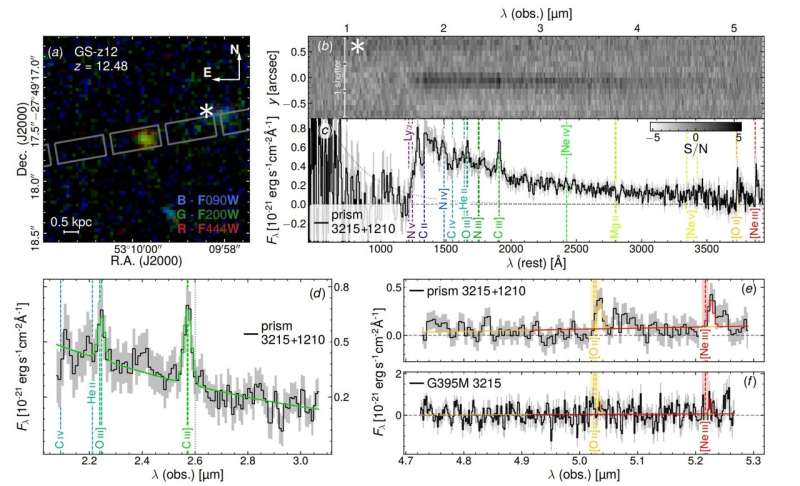This article has been reviewed according to Science X's editorial process and policies. Editors have highlighted the following attributes while ensuring the content's credibility:
fact-checked
peer-reviewed publication
trusted source
proofread
Earliest detection of metal challenges what we know about the first galaxies

Astronomers have detected carbon in a galaxy just 350 million years after the Big Bang, the earliest detection of any element in the universe other than hydrogen.
Using the James Webb Space Telescope (JWST), an international team of astronomers led by the University of Cambridge observed a very young galaxy in the early universe and found that it contained surprising amounts of carbon, one of the seeds of life as we know it.
In astronomy, elements heavier than hydrogen or helium are classed as metals. The very early universe was almost entirely made up of hydrogen, the simplest of the elements, with small amounts of helium and tiny amounts of lithium.
Every other element that makes up the universe we observe today was formed inside a star. When stars explode as supernovas, the elements they produce are circulated throughout their host galaxy, seeding the next generation of stars. With every new generation of stars and "stardust," more metals are formed, and after billions of years, the universe evolves to a point where it can support rocky planets like Earth and life like us.
The ability to trace the origin and evolution of metals will help us understand how we went from a universe made almost entirely of just two chemical elements, to the incredible complexity we see today.
"The very first stars are the holy grail of chemical evolution," said lead author Dr. Francesco D'Eugenio, from the Kavli Institute for Cosmology at Cambridge. "Since they are made only of primordial elements, they behave very differently to modern stars. By studying how and when the first metals formed inside stars, we can set a time frame for the earliest steps on the path that led to the formation of life."
Carbon is a fundamental element in the evolution of the universe, since it can form into grains of dust that clump together, eventually forming into the first planetesimals and the earliest planets. Carbon is also key for the formation of life on Earth.
"Earlier research suggested that carbon started to form in large quantities relatively late—about one billion years after the Big Bang," said co-author Professor Roberto Maiolino, also from the Kavli Institute. "But we've found that carbon formed much earlier—it might even be the oldest metal of all."
The team used the JWST to observe a very distant galaxy—one of the most distant galaxies yet observed—just 350 million years after the Big Bang, more than 13 billion years ago. This galaxy is compact and low mass—about 100,000 times less massive than the Milky Way.
"It's just an embryo of a galaxy when we observe it, but it could evolve into something quite big, about the size of the Milky Way," said D'Eugenio. "But for such a young galaxy, it's fairly massive."
The researchers used Webb's Near Infrared Spectrograph (NIRSpec) to break down the light coming from the young galaxy into a spectrum of colors. Different elements leave different chemical fingerprints in the galaxy's spectrum, allowing the team to determine its chemical composition. Analysis of this spectrum showed a confident detection of carbon, and tentative detections of oxygen and neon, although further observations will be required to confirm the presence of these other elements.
"We were surprised to see carbon so early in the universe, since it was thought that the earliest stars produced much more oxygen than carbon," said Maiolino. "We had thought that carbon was enriched much later, through entirely different processes, but the fact that it appears so early tells us that the very first stars may have operated very differently."
According to some models, when the earliest stars exploded as supernovas, they may have released less energy than initially expected. In this case, carbon, which was in the stars' outer shell and less gravitationally bound than oxygen, could have escaped more easily and spread throughout the galaxy, while a large amount of oxygen fell back and collapsed into a black hole.
"These observations tell us that carbon can be enriched quickly in the early universe," said D'Eugenio. "And because carbon is fundamental to life as we know it, it's not necessarily true that life must have evolved much later in the universe. Perhaps life emerged much earlier—although if there's life elsewhere in the universe, it might have evolved very differently than it did here on Earth."
The results have been accepted for publication in the journal Astronomy & Astrophysics and are based on data obtained within the JWST Advanced Deep Extragalactic Survey (JADES). The paper is currently available on the arXiv preprint server.
More information: Francesco D'Eugenio et al, JADES: Carbon enrichment 350 Myr after the Big Bang in a gas-rich galaxy, arXiv (2023). DOI: 10.48550/arxiv.2311.09908
Journal information: Astronomy & Astrophysics , arXiv
Provided by University of Cambridge





















